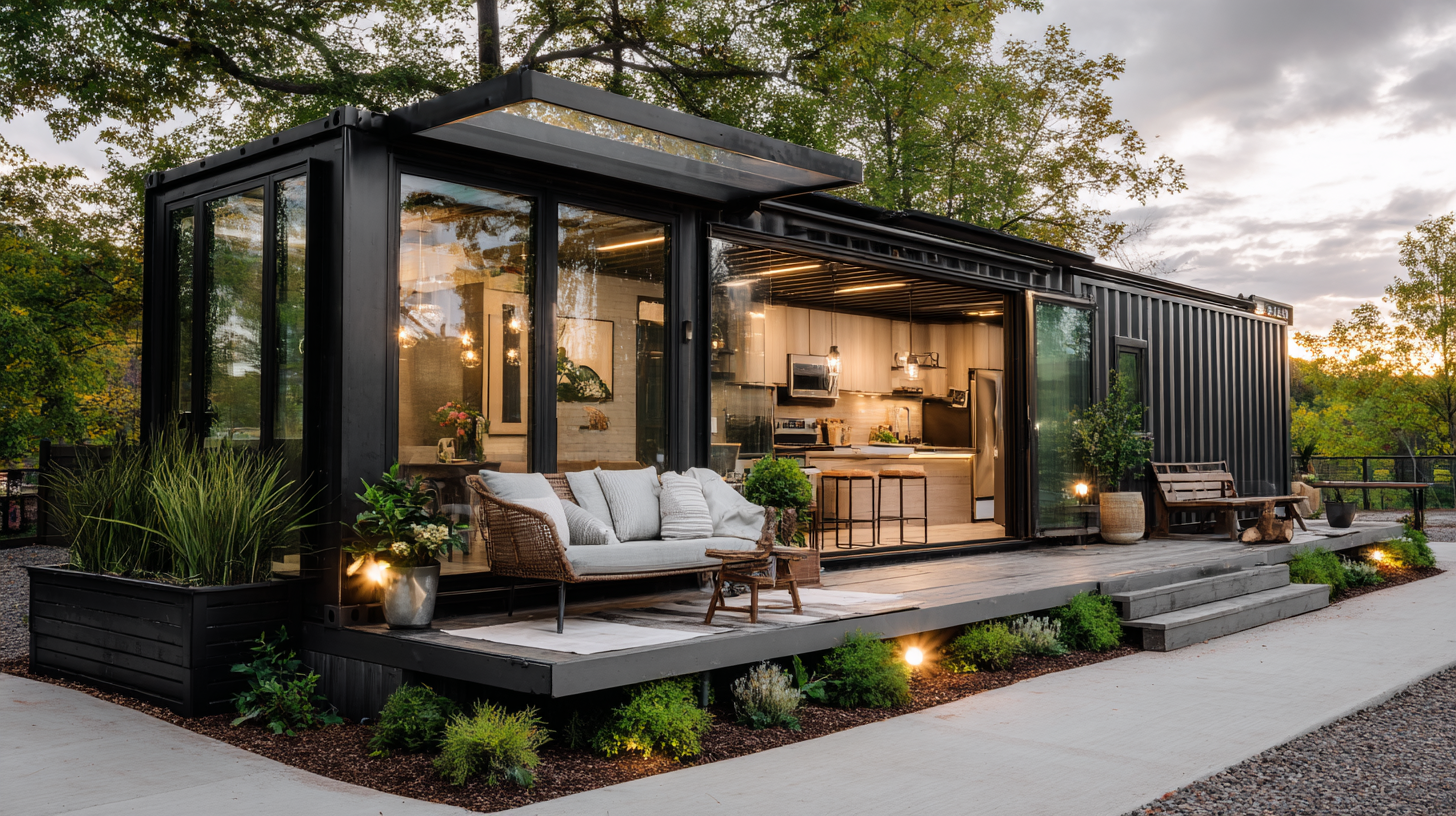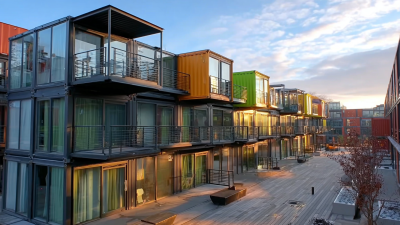Exploring the Benefits of Sustainable Living in Shipping Containers
As the global housing crisis continues to intensify, innovative solutions like shipping container living have emerged as viable alternatives for sustainable living. According to a recent report from the United Nations, by 2030, over 1.6 billion people will lack adequate housing, pushing the need for sustainable and affordable housing solutions to the forefront of urban planning. Shipping containers, often viewed as mere transportation vessels, are finding new life as eco-friendly homes that minimize waste and utilize recycled materials. A study by the Ellen MacArthur Foundation indicates that adopting circular economy practices in construction can reduce carbon emissions by up to 70%.

Moreover, the versatility of shipping containers allows for customizable designs that can adapt to various climates and urban landscapes. This makes shipping container living not only a practical solution to housing shortages but also a step towards more sustainable urban development.
The Economic Advantages of Shipping Container Homes: Cost-Effectiveness and Affordability
The economic advantages of shipping container homes have gained remarkable attention in recent years, as more individuals and families seek affordable housing solutions. According to a report by the Container Housing Association, building with shipping containers can reduce construction costs by 20-30% compared to traditional homes. This significant saving stems from the structural integrity of the containers, which often require less material for building foundations and framing, making them both cost-effective and environmentally friendly.
Additionally, the affordability of shipping container homes can be particularly appealing in urban areas where real estate prices continue to soar. The National Association of Realtors indicated that the median home price in metropolitan areas can exceed $350,000, while a well-designed shipping container home can be constructed for as little as $50,000. This dramatic difference opens up new opportunities for first-time homebuyers and low-income families, allowing them to achieve the dream of homeownership without the burden of hefty mortgages. As the demand for affordable housing grows, sustainable living through shipping container homes not only addresses economic challenges but also promotes environmental responsibility.

Environmental Impact of Sustainable Living: Reducing Carbon Footprints in Container Housing
Sustainable living in shipping containers offers a unique approach to reducing our environmental impact. By transforming these robust structures into homes, we can significantly minimize our carbon footprints. Container housing requires fewer resources to construct than traditional buildings, as they are often repurposed rather than newly built. This not only conserves raw materials but also reduces waste, making it a more eco-friendly option.
Tips for implementing sustainable practices in container living include using solar panels to harness renewable energy, which can drastically cut reliance on fossil fuels. Additionally, opting for energy-efficient appliances and fixtures will lower energy consumption and costs. Consider incorporating rainwater harvesting systems to utilize natural water sources and further decrease the household's carbon footprint.
By embracing practices like growing your own food in vertical gardens, container homes foster a self-sufficient lifestyle that contributes positively to the environment. This approach not only enhances food security but also reduces the carbon emissions associated with transportation and packaging of store-bought food. Sustainable living in shipping containers exemplifies how innovative housing solutions can lead to a greener future.
Flexibility and Adaptability: Customization Options for Shipping Container Architecture
Shipping container architecture has emerged as a flexible and innovative solution for modern living. One of the key advantages of using shipping containers is their inherent adaptability. These robust structures can be easily modified to create unique living spaces tailored to individual preferences. From cozy homes to compact offices, the customization options are virtually limitless. By incorporating elements such as large windows, skylights, and thermal insulation, designers can transform a simple container into an inviting, energy-efficient dwelling.

Moreover, the modular nature of shipping containers enables them to be stacked or arranged in various configurations, allowing for diverse architectural designs. This flexibility also means that they can fit seamlessly into a wide range of environments, whether in urban settings or rural landscapes. With advancements in construction techniques and design software, architects can experiment with different layouts and features, ensuring that each project reflects the personal style and needs of its occupants. As a result, shipping container homes represent not only sustainability but also a creative canvas for those seeking to express their individuality in their living spaces.
Durability and Resilience: How Shipping Containers withstand Harsh Weather Conditions
Shipping containers have emerged as a popular solution for sustainable living, primarily due to their remarkable durability and resilience. Designed to transport goods across the world, these steel structures are built to withstand the harshest conditions, making them an ideal choice for eco-friendly homes. Their robust construction enables them to endure severe weather events, including heavy winds, torrential rain, and extreme temperatures, ensuring the safety and longevity of the living space within.
In addition to their strength, shipping containers are also resistant to pests and decay, which are common issues in traditional housing. This resilience significantly reduces maintenance costs and extends the lifespan of the structure, making it a smart investment for those interested in sustainable living. Original features, such as insulation and ventilation, can be incorporated into the design, enhancing comfort while maintaining energy efficiency. As more people seek innovative solutions to housing challenges, the adaptability and endurance of shipping containers provide a compelling option for building resilient, eco-conscious communities.
Exploring the Benefits of Sustainable Living in Shipping Containers
| Feature | Description | Benefits |
|---|---|---|
| Durability | Made from robust steel, shipping containers are designed to endure heavy loads and rough transport conditions. | Long lifespan, low maintenance costs, and ability to withstand physical stresses. |
| Weather Resistance | Containers are built to protect goods from rain, wind, snow, and sun. | Prevents water damage and reduces the need for additional protective measures. |
| Insulation | Can be insulated to maintain interior temperature. | Energy efficiency and comfort in varying climates. |
| Eco-friendly | Repurposing used containers reduces waste and encourages recycling. | Lower carbon footprint and promotion of sustainable practices. |
| Mobility | Shipping containers can be transported easily and relocated. | Flexibility in location and adaptability to various needs. |
Community Building through Container Living: Fostering Sustainability and Collaboration
Container living encourages community building and sustainable practices, fostering collaboration among residents. By creating shared spaces and resources, individuals can contribute to a more cohesive and supportive environment. Research indicates that neighborhoods with strong social ties can increase resilience to climate challenges. For instance, residents in communities like Earthaven Ecovillage in North Carolina have seen firsthand how knowing their neighbors enhances their ability to tackle environmental issues together.
Moreover, modular construction, often employed in container living designs, offers an innovative approach to sustainable housing. While barriers such as financial constraints and regulatory hurdles exist, initiatives in cities like Cleveland are paving the way for transformative housing solutions. With programs aiming to create thousands of affordable homes, leveraging sustainable practices in construction not only addresses the housing crisis but also promotes community welfare.
Tips for fostering collaboration in container living include hosting regular community events to strengthen relationships and encouraging cooperative projects like shared gardens, which can enhance food security and reduce carbon footprints. Additionally, integrating digital platforms can facilitate better communication and coordination among residents, ensuring that everyone participates in sustainability efforts.
Benefits of Sustainable Living in Shipping Containers
Related Posts
-

Innovative Ways to Transform Shipping Container Rooms into Sustainable Living Spaces
-

How a 40ft Container Cabin Can Transform Your Living Space into an Ecofriendly Haven
-

Innovative Ideas for Shipping Container Remodels You Can Try Today
-

Discovering the Future of Living: The Rise of Container Condos as Eco-Friendly Housing Solutions
-

Innovative Uses of Shipping Container Buildings Transforming Modern Architecture
